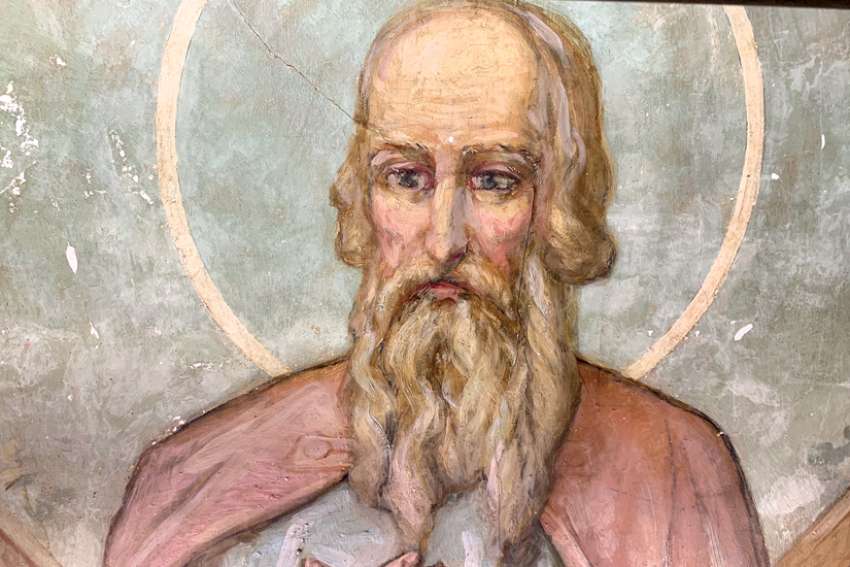It was early September and she was mere weeks away from achieving closure on a restoration project that began a decade ago.
“I am perched almost atop the inside of the church and I can see all the murals right now as one of my conservators painting right now, and it’s just amazing to see how beautiful they are,” said Gallinger as she spoke with The Catholic Register.
“The difference from going from dead-looking ‘floating saints’ that have no character or purpose on the wall, to these glowing, beautiful paintings is just astounding to see.”
Gallinger was commissioned to restore 14 murals to their original artistic brilliance. Each painting was rendered in 1902 by Ozias Leduc (1864-1955), hailed during his period as “the Michelangelo of Canada.” The artist from Saint-Hilaire-de-Rouville, Que., whose work graced over 150 parishes during his lifetime, was inspired to ornament the cathedral’s walls and columns with depictions of the 12 apostles, St. John the Baptist, St. Cecilia and two angels of God holding tablets.
“We are completing the final brushstrokes for the paintings now,” said Gallinger. “I will come back within a week to do the varnishing, but our work will be done and the scaffolding is scheduled to come down by the 25th of September.”
Architects behind renovations to the house of worship in 1937 declared the interior needed a fresh coat of paint. Many canvases were covered by this new layer, and future revamps ultimately shrouded Leduc’s work under seven films of paint and two coverings of plaster. Isolated heads from these figures remained visible, leading to the paintings being dubbed “the floating saints.”
Thanks to a steady stream of private donations over the past 10 years adding up to $500,000, Gallinger and her crew have spent four months per year in Antigonish many summers restoring multiple murals. On average, it takes about six-to-eight weeks to restore a single depiction. The final three paintings — St. John, St. James and St. Andrew — have been fixed over this summer.
Gallinger and her co-workers stared down multiple races against time while completing this work of artistic healing. The cathedral parish wanted the project to be completed in time for St. Ninian’s 150th anniversary in 2024. Mission accomplished with a hearty amount of time to spare.
More importantly, with each passing year there are peelings causing more of Leduc’s original work to be lost. Pinpoint precision is required every step of the way, whether the process calls for gluing, humidifying, tacking irons, reframing and, of course, painting.
Reinstating St. John this summer required the most miraculous work out of Gallinger and her associates Ruth Delfresno-Guillm, Tirza Harris and Bronwyn Bond.
“Actually 80 per cent of him was in critical condition,” said Gallinger. “If you would have touched it, he would have flipped off the wall and fallen to the ground. He took 13 weeks to complete. We had a major loss of John due to all the painting, and most of John was gone due to past painters aggressively scraping the walls. It was devastating. We had to paint in most of his left column because it was completely scraped away.”
Gallinger’s association with St. Ninian’s Cathedral, which unofficially dates back to 1999 when an exploratory committee first floated the notion of a restoration project, has put her up close and personal with Leduc’s mastery. The closer the work approached completion, the more Gallinger experienced and marveled at his grand design.
“If you step in here, you could not imagine how serene and beautiful the colours are. The Leduc paintings have a glow to them. They are not flat. It is very much like the saints coming to join you in the church from their home. They are not just statues anymore.”
Resurrecting Leduc’s murals represents a landmark accomplishment for Gallinger and the St. Ninian’s community at large, but she hopes that community support remains passionate enough for two more projects to be greenlit.
Gallinger said she would appreciate the opportunity to restore the ceiling in St. Ninian’s nave. The roundels (circular discs encompassing symbols) and quatrefoils (decorative, symmetrical shapes with four overlapping circles) containing decorations from the life of Christ and other religious symbols, such as the Lamb of God, the Holy Spirit and the Eye of God.
Leduc’s original sanctuary vault, featuring God the Father and His angels flanking Him left and right, is obscured by renovations. She said restoring the vault will bring Leduc’s overall concept for the parish back to life. She said Leduc designed his art as a narrative timeline dating back to the time of Christ, leading up to the contemporary Catholic Church.


